Interval variety
The interval variety of an interval class in a scale is the number of different interval qualities available for that interval class. For example, the interval class "fifth" in the diatonic scale has interval variety 2, because there are two sizes of fifths in that scale: 6 perfect fifths and 1 diminished fifth.
The concept of interval variety can be applied to all interval classes of a scale at once. The most signficant of such properties is the highest interval variety, or maximum variety. Other properties might include the mean interval variety, median interval variety, and lowest interval variety. In addition, strict variety (SV) scales, such as single-period mos scales and trivalent scales, have the same interval variety for all interval classes (except the unison, which always trivially has interval variety 1).
It is crucial to remember that variety properties of a concrete scale and variety properties of an abstract scale word mean different things. Namely, if certain linear relations hold between step sizes, the abstract scale word may satisfy different variety properties than the concrete tuning of it. The modifier abstractly is used to emphasize that the variety property holds for the scale pattern represented by the scale, not merely or necessarily for the concrete scale. For example, the scale pattern 0102103012 is abstractly minimum variety 4, but (almost all) tunings of the pattern that satisfy 0 + 3 = 1 + 2 will be minimum variety 3.
Terminology
For abstract scale words, the standard academic counterpart to the xen term variety is the abelian complexity function of a word: a function ρab: N → N where ρab(n) is the number of distinct sizes (abelianizations, living in a free abelian group over the step sizes) that length-n subwords can have in a word.
Maximum variety
The maximum variety (MV) of a scale is a way of quantifying how many different "flavors" of intervals there are in it. Scales with high maximum variety have many different intervals of similar size occuring at different places in the scale. Scales with low maximum variety may be easier for composers and listeners to understand, because there is more uniformity and consistence between different parts of the scale. In a low maximum variety scale, simply knowing how many scale steps an interval spans gives you a lot of information about the interval (by narrowing it down to a small set of choices).
An interval class is the set of all interval sizes of a scale which span a given number of steps. For example, in the diatonic scale, the 2-step class consists of the minor third and the major third, because those are the only intervals that are divided into 2 steps of the scale. The "variety" of an interval class is the number of different intervals in it. The maximum variety of a scale is simply the maximum variety of any interval class.
Any scale with all equal steps (such as an edo) has maximum variety 1. All mos scales have maximum variety 2. An example of a scale with high maximum variety is the harmonic series, because the steps get gradually smaller as you go up the scale, and none of them are equal.
Maximum-variety-3 scales
The commonly discussed mos property can be characterized as follows, as well as in other equivalent ways: Every set of (non-unison reduced) generic intervals has size at most 2. We can rephrase this as saying that the maximum variety of the scale is 2, or that the scale is maximum variety 2 (MV2). Maximum variety 3 (MV3) is the generalization of the MV2 characterization of the mos property to ternary scales. Other characterizations of the mos property, such as distributional evenness and having a generator, generalize to ternary scales differently.
There is a theorem classifying all possible MV3 scales; see Ternary scale theorems.
Generating MV3 scales
Once you have chosen a rank-3 temperament and a specific generator interval, there is a mechanical procedure to generate all max-variety-3 scales of a certain size (of which there are, however, infinitely many).
To illustrate this process, let us use the simplest and most familiar rank-3 system: 5-limit JI, and let us use 3/2 as a generator. Because 3/2 is the generator, these max-variety-3 scales will be related (albeit not in a simple 1-to-1 way) with mos scales of Pythagorean tuning, the rank-2 temperament with 3/2 as a generator.
Numbers of notes in Pythagorean mos scales follow the pattern 1 + 1 = 2, 2 + 1 = 3, 2 + 3 = 5, 5 + 2 = 7, 5 + 7 = 12… (related to the continued fraction for log2(3/2)). The numbers of notes in the 5-limit max-variety-3 scales we are constructing will be related to these by having one of the numbers repeated. Therefore the possible sizes are:
- 1 + 1 + 1 = 3, 2 + 1 + 1 = 4, 2 + 2 + 1 = 5, 2 + 2 + 3 = 7, 2 + 3 + 3 = 8, 5 + 2 + 2 = 9, 5 + 5 + 2 = 12, 5 + 5 + 7 = 17, 5 + 7 + 7 = 19, …
If the number of notes is even, the max-variety-3 scale consists of two chains of 3/2 of equal length, each of which contains half the notes. If the number of notes is odd, the two 3/2-chains differ by 1 in length.
Any scale at all with only 3 notes has max variety 3, so let us begin with the 4-note scales. A 4-note scale consists of two parallel 3/2 intervals separated by some other 5-limit interval. Although strictly speaking this could be any other 5-limit interval at all, if the two chains are separated from each other there will be no potential for 5-limit harmony. For these 4-note scales it turns out that all the configurations work, so we can easily list all the possible scales: … {1/1, 10/9, 3/2, 5/3}, {1/1, 5/4, 3/2, 5/3}, {1/1, 5/4, 3/2, 15/8}, {1/1, 45/32, 3/2, 125/64}… Only the ones where the two chains are lined up closely have good potential for harmony.
The 5-note scales will consist of a chain of 3 notes and a parallel chain of 2 notes. The 3-note chain has the pattern {1/1, 9/8, 3/2}, and to make a max-variety-3 scale, the other chain of 2 notes must be separated by 4/3, falling between the large (4/3) steps of the 3-note chain (between 9/8 and 3/2, and between 3/2 and 2/1). If either of the notes falls between 1/1 and 9/8, the scale will not be max-variety-3. Let us look at all the scales we get as we move the 2-note chain past the 3-note chain in the 5-limit lattice.
1/1 9/8 40/27 3/2 160/81 … max variety 3
1/1 10/9 9/8 40/27 3/2 … fails, max variety 4
1/1 10/9 9/8 3/2 5/3 … fails, max variety 4
1/1 9/8 5/4 3/2 5/3 … max variety 3
1/1 9/8 5/4 3/2 15/8 … fails, max variety 5
1/1 9/8 45/32 3/2 15/8 … max variety 3
1/1 135/128 9/8 45/32 3/2 … fails, max variety 4
1/1 135/128 9/8 3/2 405/256 … fails, max variety 4
1/1 9/8 1215/1024 3/2 405/256 … max variety 3
Examples testing for MV
MV2
Positive
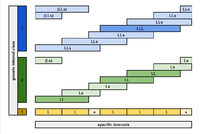
Consider the 5L 2s diatonic scale: LLsLLLs. For each generic interval class, we must confirm that there are only 2 specific intervals:
- L, s
- LL, Ls
- LLL, LLs
Actually we only have to check up to halfway, because all of the generic interval classes beyond this are period complements of the ones we already checked. And so it is confirmed: this is an MV2.
Negative
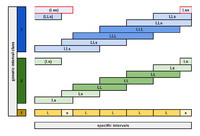
How about a counterexample, LsLLLLs:
- L, s
- LL, Ls
- LLL, LLs, sLs — stop!
We have found that for the generic interval class 3, this scale has three different specific intervals, so it is not MV2.
MV3
Positive
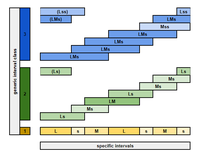
Consider the 2L 2M 3s scale with pattern LsMLsMs.
- L, M, s
- Ls, Ms, LM
- LMs, Mss, Lss
Great, this is MV3.
Negative
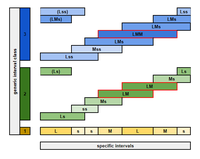
Consider the 2L 2M 3s scale with pattern LssMLMs.
- L, M, s
- Ls, ss, Ms, LM — stop!
This scale has more than three different specific intervals for a generic interval class, so it is not MV3.
Conditional
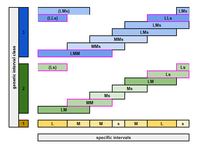
How about the 2L 3M 2s scale with pattern LMMsMLs?
- L, M, s
- LM, MM, Ms, Ls — stop! … but wait. What if MM=Ls? Then actually this would still be only 3 specific intervals. So let's go with that, and continue.
- LMM=LLs, MMs, LMs
So this scale is Conditionally MV3 (Ls).
Facts about variety properties of scale words
In the following, two letters are to be considered the same if their numerical values are congruent modulo n.
Theorem — For all n ≥ 1, the word 0123…(n − 1) is SV-n.
Theorem — For all n ≥ 1, the word 0123…(n − 2)(n − 1)(n − 2)…3210 is SV-n.
Consider the subwords 0123…(n − 2)(n − 1) and (n − 1)(n − 2)…3210. If we treat these two words as noncircular, then there are n − k distinct k-letter subwords.
Now consider the k-letter noncircular subword (r − 1)(r − 2)…210012…(s − 2)(s − 1), where r, s ≥ 1. Note that interchanging r and s yields equivalent subwords. If k is odd, there are (k − 1)/2 distinct subwords of this kind; if k is even, there are k/2 subwords, each corresponding to a solution of r + s ≥ k.
A similar thing goes with (n − r − 1)…(n − 2)(n − 1)(n − 2)…(n − s − 1). If k is odd, there are (k + 1 )/2 distinct subwords of this kind; if k is even, there are k/2 subwords, each corresponding to a solution of r + s − 1 ≥ k.
Thus there are
[math]\displaystyle{ n - k + \frac{k - 1}{2} + \frac{k + 1}{2} = n \qquad \left(k\,\text{odd}\right) }[/math]
[math]\displaystyle{ (n - k) + 2\left(\frac{k}{2}\right) = n \qquad \left(k\,\text{even}\right) }[/math]
distinct k-letter subwords, so the word is SVn. [math]\displaystyle{ \square }[/math]Abstractly SV4 scale patterns
Abstractly SV4 scale patterns (patterns that are SV4 for any choice of distinct cent values for the four steps):
- 4 notes: 0123
- 5 notes: 01023
- 6 notes: none
- 7 notes: 0123210, 0102013, and 0103102 (The last two patterns are a chiral pair fixing concrete sizes for the steps.)
- 8 notes: 00100232 and 01212103
- 9 notes: none
- 10 notes: 0010020302 and 0102103012
- 11 to 14 notes: none
(Note that abstract SV4-ness implies that a scale pattern is primitive, or single-period.)
Conjecture: there are no SV4 scale patterns with more than 10 notes.
Maximum variety of balanced words
A balanced word or necklace in N letters has a maximum variety bound of [math]\displaystyle{ N \choose {\left\lceil N/2 \right\rceil} }[/math].
Open questions
- Why are (abstractly) SV4 scale patterns seemingly so rare?
- Conjecture: There are only finitely many SV4/MV4 circular words.
- Conjecture: For all n greater than a sufficiently large m, the longest abstractly SV-n word is 0123…(n − 2)(n − 1)(n − 2)…3210, with length 2n − 1.
- The following conjecture may be key to proving the ones above: For a sufficiently long ternary noncircular word, there exists k > 1 such that the interval class of k-steps has at least 3 sizes and the interval class of (k − 1)-steps also has at least 3 sizes.